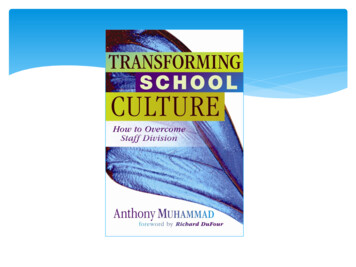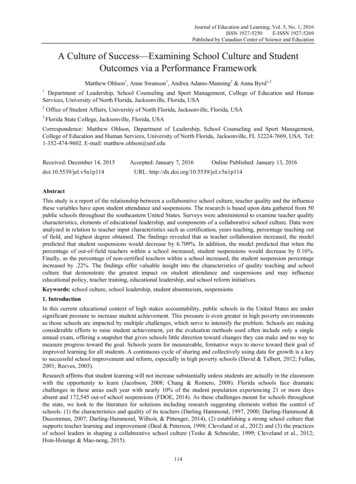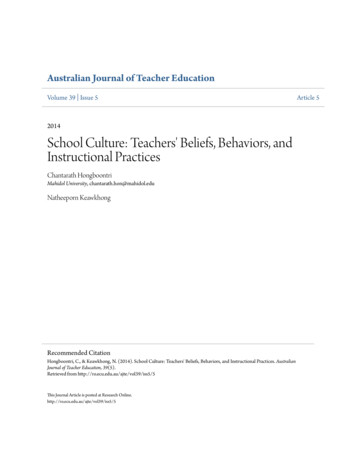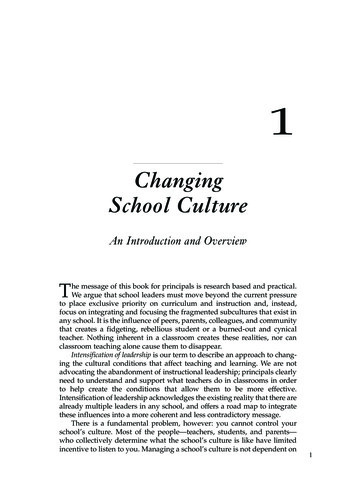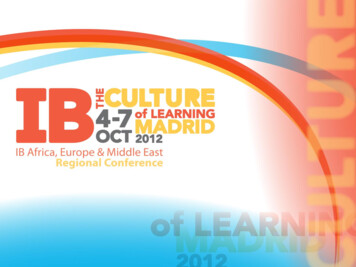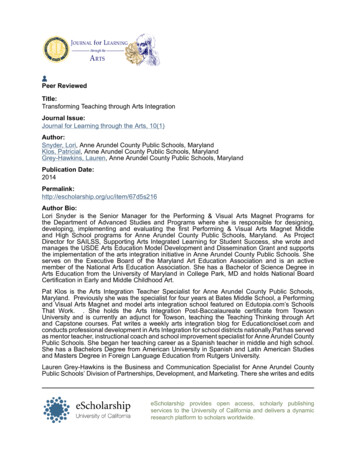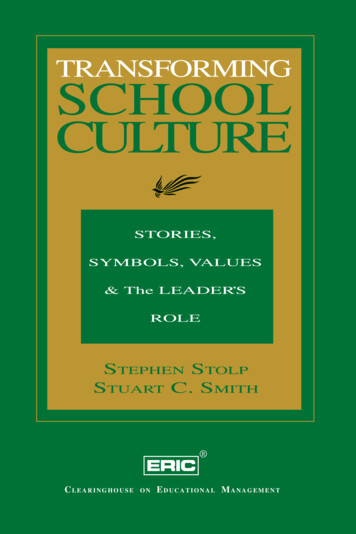
Transcription
TRANSFORMINGSCHOOLCULTURESTORIES,SYMBOLS, VALUES& The LEADER’SROLESTEPHEN STOLPSTUART C. SMITH CLEARINGHOUSEONEDUCATIONAL MANAGEMENT
TRANSFORMINGSCHOOLCULTURESTORIES,SYMBOLS, VALUES& The LEADER’SROLESTEPHEN STOLPSTUART C. SMITH CLEARINGHOUSE ON EDUCATIONAL MANAGEMENTUNIVERSITY OF OREGON1995
Copyright 1995 University of OregonAll rights reserved. No part of this publication may be reproduced,stored in a retrieval system, or transmitted in any form or by anymeans, electronic, mechanical, photocopying, recording or otherwise,without permission in writing from the Publisher.Library of Congress Cataloging-in-Publication DataStolp, Stephen Wayne.Transforming school culture: stories, symbols, values, andthe leader’s role/ Stephen Stolp and Stuart C. Smith ;foreword by Terrence E. Deal.p.cm.Includes bibliographical references.ISBN 0-86552-132-81. School management and organization—United States.2. School environment—United States. 3. School improvementprograms—United States. 4. Educational leadership—UnitedStates. 5. School principals—United States. I. Smith, StuartCarl, 1944.II. ERIC Clearinghouse on Educational Management.III. Title.LB2805.S748 1995371.2‘00973—dc2095-19368CIPPrinted in the United States of America, 1995Design: LeeAnn AugustType: 10.5/12.5 PalatinoPrinter: Thomson-Shore, Dexter, MichiganERIC Clearinghouse on Educational ManagementUniversity of Oregon1787 Agate StreetEugene, OR 97403-5207Telephone: (503) 346-5043 Fax: (503) 346-2334ERIC/CEM Accession Number: EA 026 696This publication was prepared in part with funding from the Officeof Educational Research and Improvement, U.S. Department ofEducation, under contract no. OERI-RR 93002006. The opinionsexpressed in this report do not necessarily reflect the positions orpolicies of the Department of Education. No federal funds were usedin the printing of this publication.The University of Oregon is an equal opportunity, affirmativeaction institution committed to cultural diversity.ii
MISSION OF ERICAND THE CLEARINGHOUSEThe Educational Resources Information Center (ERIC) is a nationalinformation system operated by the U.S. Department of Education.ERIC serves the educational community by disseminating researchresults and other resource information that can be used in developingmore effective educational programs.The ERIC Clearinghouse on Educational Management, one of severalsuch units in the system, was established at the University of Oregonin 1966. The Clearinghouse and its companion units process researchreports and journal articles for announcement in ERIC’s index andabstract bulletins.Research reports are announced in Resources in Education (RIE), available in many libraries and by subscription from the United StatesGovernment Printing Office, Washington, D.C. 20402-9371.Most of the documents listed in RIE can be purchased through theERIC Document Reproduction Service, operated by Cincinnati BellInformation Systems.Journal articles are announced in Current Index to Journals in Education.CIJE is also available in many libraries and can be ordered from OryxPress, 4041 North Central Avenue at Indian School, Suite 700, Phoenix, Arizona 85012. Semiannual cumulations can be ordered separately.Besides processing documents and journal articles, the Clearinghouseprepares bibliographies, literature reviews, monographs, and otherinterpretive research studies on topics in its educational area.CLEARINGHOUSENATIONAL ADVISORY BOARDTimothy J. Dyer, Executive Director, National Association of Secondary School PrincipalsPatrick Forsyth, Executive Director, University Council for Educational AdministrationPaul Houston, Executive Director, American Association of SchoolAdministratorsJoyce G. McCray, Executive Director, Council for American PrivateEducationJoseph Murphy, Vice-President, Division A, American EducationalResearch AssociationMaggie Rogers, Director, Information Center, Northwest RegionalEducational LaboratorySamuel Sava, Executive Director, National Association of ElementarySchool PrincipalsThomas Shannon, Executive Director, National School BoardsAssociationDon I. Tharpe, Executive Director, Association of School BusinessOfficials InternationalBrenda Welburn, Executive Director, National Association of StateBoards of EducationADMINISTRATIVE STAFFPhilip K. Piele, Professor and DirectorStuart C. Smith, Associate Director for Publicationsiii
CONTENTSPreface . viiAcknowledgments . ixForeword . xiPrologue . 1A Class Ritual . 1The Meaning of Classroom Architecture . 2A Principal’s Style of Communication . 4History of a School’s Front Office . 5Introduction . 71.What Are School Culture and Climate? . 11Origins of the Concepts of Culture . 12Strong Culture a Prerequisite for Reform . 13Relationship Between Culture and Climate . 15Culture: An Expanded Vision . 16Limitations on the Term “Culture” . 18Building a Shared Understanding . 19Creative Use of Both Terms . 202.The Importance of School Culture:Evidence from the Research . 21Landmark Studies . 22NASSP’s Comprehensive Assessmentof School Environments . 23Culture and School Reform . 24Professional Community . 26Student Motivation . 28Student Achievement . 29Leadership and Organizational Culture . 30v
viStrong versus Weak Cultures . 31Safe and Unsafe Schools . 32Lessons of Experience . 333.Three Levels of Culture . 35Tangible Artifacts . 36Values and Beliefs . 38Underlying Assumptions . 39Culture Is Active, Not Static . 404.Identifying and Measuring Culture . 41Artifacts and Change in School Culture . 41History and Change in School Culture . 43Underlying Assumptions: Defining “What Isn’t” . 44Instruments for Measuring Climate and Culture . 44The More Things Change. . . . 495.Transforming School Culture: A Systems View . 51Five Principles of Systems Thinking . 52Correlates of an Effective Culture . 53CASE-IMS School Improvement Process . 55Changing Artifacts—A Systems View . 566.Transforming School Culture: Shared Vision . 59Creating Shared Responsibility . 60Guidelines for Creating a Vision . 61The Principal’s Role . 637.Transforming School Culture: The Role of the Leader . 67New Leadership Roles . 68Reflection and Dialogue . 72Using Narrative . 73Organization of the School Day . 75Setting a Consistent Example . 76Staff Development . 76Selecting Compatible Staff . 77Recognizing Staff Members . 78Lessons for the Principal . 79Conclusion . 81Bibliography . 83vi
PREFACEToday as never before, problems of the outside world encroach on the school environment. Child abuse,gangs, broken families, drugs, violence, and environmentalproblems all to varying degrees hinder the school’s abilityto educate students. The challenge for school leaders is toshape and nurture a school culture that can address thesegrowing problems. The school can no longer be seen as justa place for basic instruction. For many students, it servesthe function of a home, providing moral direction and asense of belonging.The concept of school culture offers school and districtleaders a more holistic way to look at the school. By deepening their understanding of culture, school leaders will bebetter able to influence the values, beliefs, and underlyingassumptions held by all members of the school community,with the goal of building an ethos of excellence and caring.Perhaps the most important ability of today’s school leaderis to be a culture builder, one who instills the values ofconcern for others, personal and group success, and continuous improvement.The ERIC Clearinghouse on Educational Management ispleased to publish Transforming School Culture: Stories, Symbols, Values, and the Leader’s Role, which guides principals,other administrators, and teachers in the process of shapingthe culture of their schools. For those who have alreadybegun the process, the book provides insights, examples,and reassurance that their efforts are headed in the rightdirection.vii
viiiStephen Stolp is an assistant professor in the honorscollege at the University of Oregon. He received his doctoraldegree from the University of Oregon in 1993. He has writtenarticles and produced videos on a variety of topics, including educational culture, education for a sense of place,primary socialization, and the use of metaphor in the classroom.Stuart C. Smith is the Clearinghouse’s associate directorfor publications. He has authored books and articles onfaculty collaboration and a variety of issues related to schoolleadership.Philip K. PieleProfessor and DirectorERIC Clearinghouse on Educational Managementviii
ACKNOWLEDGMENTSThis book was prepared in cooperation withthe Oregon School Study Council, which published an earlier,shorter version in its OSSC Bulletin series (January 1994).Terrence E. Deal, professor of education at VanderbiltUniversity, and James W. Keefe, director of research for theNational Association of Secondary School Principals, readseveral drafts and kindly offered many suggestions thatadded to the book’s theoretical and practical value. Weespecially appreciate the depth and thoroughness of Dr.Keefe’s comments and thank him also for sharing with usinformation on NASSP’s Comprehensive Assessment ofSchool Environments program.Portions of this book will be used as a chapter in SchoolLeadership: Handbook for Excellence, third edition, ERIC Clearinghouse on Educational Management, forthcoming.“School Climate,” a chapter in that book’s second edition(1989), was written by John Lindelow, Jo Ann Mazzarella,James J. Scott, Thomas I. Ellis, and Stuart C. Smith. Theauthors of this revision acknowledge the contribution ofthose earlier writers. Several paragraphs from the 1989edition have been incorporated into this text.Meta Bruner performed the keyboarding of successivedrafts with her usual skill and good cheer.Few writers’ words have been presented in as appealinga setting, for which we thank LeeAnn August for her coverdesign and text layout.ix
FOREWORDSince time began, humans have recognizedthe spiritual side of life in human groups. Historicallypeople have struggled to give this elusive, ethereal force aname: mythos, spirit, saga, magic. No matter what namewas assigned, people stood in awe of this powerful forcebecause it gave life meaning, passion, and purpose. As bothNeitzche and Ibsen observed, life requires supporting illusions and when these illusions wane or burst, the bottomdrops out and we lose our way.In our contemporary world we still struggle to define,create, and maintain the spirit of life in cooperative enterprises. In the early 1980s, businesses refound an old termthat anthropologists coined to capture the subterranean forcesin human societies—culture. Businesses struggled to buildor reinforce cultural patterns on the basis of evidence linkinga cohesive culture to financial performance. A recent studyby Kotter and Hasklett provides ample longitudinal evidence showing that the link between culture and performance is more than imagined.In education, we called the age-old mysterious forceclimate. Several studies have demonstrated that a positiveschool climate is associated with academic performance.Other educators called it ethos and again established a linkagebetween school ethos and academic achievement. Now, alongwith others, Stephen Stolp and Stuart Smith are introducing culture as an alternative way to capture the powerfulspiritual force in schools. While they favor this term ashaving more value for practitioners than climate, they realize that the blurred boundaries often eclipse efforts toxi
xiidraw clear lines separating the two. They wisely advisepractitioners to sort and select whatever ideas they need anduse any label they want.Whatever it is called, the spiritual side of human life ispowerful. In today’s schools, we desperately need an infusion of passion, purpose, and meaning. Decades of criticismand reform have caused the symbolic tapestry to unravel,robbing students and professionals of faith and life.Educators’ eagerness to reclaim this source of meaningis evident whenever I work in schools. Their responses alwaystell me when I get to the deeper aspects of culture. It happenswhen I introduce a different language—history, sharedvalues, heroes and heroines, rituals, ceremony, stories, andthe informal network of cultural players (priests and priestesses, story-tellers, gossipers). The language transports peopleto another level—the world of spirit. My hope is that thisbook will help educators explore beyond the psychological,structural, and political aspects of educational organizationsand discover the power of the symbolic realm to motivateand reenergize both staff and students.The major contribution Stolp and Smith make is to demonstrate how this symbolic realm can be better understoodand shaped through leadership. They provide concreteexamples showing the promises and pitfalls of working theexistential side of schools. Our (Bolman and Deal) continuing studies of principals time and time again document thatthe ability to read and respond symbolically is at the heartof effective leadership. Reading this manuscript should helpschool administrators latch on to an age-old source of wisdom.Thereafter they can help others rediscover the power ofsymbols in the human experience and as a source of schoolimprovement.Terrence E. DealProfessor of Education and Human DevelopmentVanderbilt Peabody College
1PROLOGUE“Let these describe the undescribable.”ByronMaybe you are a reader who likes a bookto begin with a definition of its topic in the abstract, propositional language academicians are fond of. If that is yourexpectation as you open this book, you will save time byturning to chapter 1. But if you do, we think you will comeaway disappointed. Even the best definition cannot adequately convey the breadth and the richness and especiallythe subtlety of a school’s culture. For in the same way thatromantic love or the taste of chocolate resists description,abstract words of the type found in most definitions (“values,” “symbols,” “relationships”) somehow fall flat in conveying the meaning of culture.All is not lost, though. Definitions may fail, but culturecomes alive in concrete descriptions of events, social interactions, and classroom behaviors, much like a romantic novelbrings us closer to the experience of love. Illustrations, stories,examples, and glimpses into the lives of people who workin schools can help to “describe the undescribable.” Thuswe begin this book with some simple descriptions of a highschool class’s ritual, a classroom’s architecture, a principal’suse of language, and a school’s front office. Such languagebreathes life into the abstract words that necessarily occupythe pages ahead.A Class RitualAn assistant principal we’ll call Marvin Washington headsa program at a high school for at-risk youth called “Learning1
2to Cope.” Most of the students in the program come frombroken homes or abusive family situations. They are required to attend group meetings twice a week as a disciplinary action, usually the result of drug use or rude andviolent behavior.The class focuses on a variety of topics and encouragesstudents to talk about their problems at home and school.Sometimes the conversations are angry and emotional. Theidea is to let students vent and share their frustrations.Washington hopes the students will gain a sense of community with other students who share similar problems andturn negative energy into positive outcomes.At the end of each session, regardless of the intensityof emotion in the room, a few minutes are set aside for“high-fives, handshakes, or hugs.” The ritual is a consistentpart of the program. It requires that students acknowledgeeach other with a handshake, high-five, or hug. “The intent,”says Washington, “is to get kids to realize that they can beangry and still be friends.”By means of this ritual, students physically interact withone another in a way that acknowledges the end of thesession and the bond between participants. The perceptioncommunicated by the physical act is one of care and concernfor one’s classmates. But beyond this surface-level understanding, it is also the intent of the ritual to instill the valuesof caring and forgiveness. Washington hopes that when thesekids find themselves in other contexts, they will rememberthe message of a hug: “to forgive and forget.” Studentsexpress these values as they take lessons beyond the schooland apply their experience to other areas of life.The “Learning to Cope” ritual exemplifies two levels ofculture: surface-level experiences and internalized normsand values, which go with us wherever we go.The Meaning of Classroom ArchitectureFrom behind a large oak desk, William Goldstein looksout at six symmetrical rows. Behind him two chalkboardsfill the wall, punctuated in the center with a standard brownrimmed clock. To his left the 800-square-foot room houses
Prologue3a no-frills high school biology laboratory complete withsinks, black counters, gas, air and water fixtures, a periodicchart of the elements, jars of dead pickled creatures, anda distinct smell of formaldehyde. Brown marble tiles on thefloor provide contrast to the white acoustic ceiling panels.A lectern, assignment baskets, and a complete human skeleton surround the front desk. The setting directs attentionto Goldstein.The visible features clearly represent a biology classroom. The architecture, interior design, and furnishingsestablish the environment. When students or staff enter theroom, they realize they have entered a school laboratory,and the desk at the front of the room distinguishes theteacher’s place from the students’. These elements are visibleand easily recognizable. Students realize they are in a science classroom.The reality of the classroom, however, goes beyond itsphysical features. The school also encodes a certain culturalperspective. As Theodore J. Kowalski (1989) states, “Theschools we erect today reflect our priorities as a people.”They suggest something about the role of education, andtheir structure reflects a particular cultural orientation.Goldstein’s room represents a microcosm of modernschooling. Straight rows of desks, two chalkboards, a standard clock, textbooks, tile floors, and acoustic ceiling panelsreveal more than the classroom’s physical environment. Theyalso say something about how our society views education—a more hidden cultural perspective.The straight rows of desks facing the front of the roomare designed to direct students’ attention toward the teacher.Hidden in the interior design of the classroom is a culturalvalue placed on disciplined learning. The hidden valueidentifies how learn 9ing should take place in Goldstein’sclassroom. Students should face the front of the room andpay attention to the biology lesson.The clock denotes the importance of keeping track oftime, but it also says something about the school culture:The school places a value on time for the purpose of learning.We sense a school’s culture both in the visible signs thatestablish an immediate perception and in the norms, values,and beliefs that are implicit in those signs.
4A Principal’s Style of CommunicationSchool culture offers the practitioner a broader frame ofunderstanding. Relationships are measured by more thanjust a shared perception. They reflect the history and valuesof the people and the institution. In this sense, the conceptof culture expands an administrator’s ability to initiate changein a school setting. Mark Harris of Valley Middle School,one of the principals who was the subject of a case studyby Terrence Deal and Kent Peterson, points out that a broaderunderstanding of the school culture allowed him to see howthe use of jargon was affecting his daily interactions.Harris says that the use of “little terms like ITIP andPSAT” really made it difficult to communicate. The acronyms were part of Harris’s everyday vocabulary, but oftenparents and staff failed to understand their meaning. Ratherthan question Mark about the meaning of such terms, “peoplejust shook their heads like they understood what I wastalking about when really they had no idea.”By listening to staff and focusing on relationships, Harriswas able to see the down side of what Deal and Petersoncall “principal talk”—using a specialized language that onlya few understand. So Harris changed not just the acronyms,but the style of his communication. Recognizing and creating a shared language, understood by all, is one way thata cultural perspective can enhance a principal’s ability totake a more broad-based approach to change. If he hadfocused on just the jargon and acronyms, he might havemissed the broader-based focus that includes not just thewords used in a particular situation, but how the communication process affects relationships.Mediating change in a school setting requires a sensitivity to shared meaning. Groups organize, coordinate, andtake action within a system created by symbolic relationships. “They arrive at certain shared understandings regarding how, when, and where activities are to occur,” explainMartin L. Maehr and Leslie J. Fyans, Jr. (1989). The negotiation of these relationships determines the type of changethat takes place within a particular culture or institution.
Prologue5History of a School’s Front OfficeWalk into the front office of any school and immediatelyyou will sense its personality. The office may appear relaxedor stressful, orderly or disorganized, formal or friendly. Thestaff may be hurrying around answering phones, typing,and responding to students. These perceptions or impressions are qualities of the immediate environment. Suchperceptions, as we explain in chapter 1, constitute the office’sclimate.To more fully understand an office’s culture, one wouldneed to delve into the history of the relationships. Forexample, one school’s front office appears on the surface tooperate smoothly and efficiently. A candid talk with thesecretary and three clerks, however, reveals that they experience an unhealthy degree of stress because of a systemof rules that the principal prescribed two years ago withgood intent—to encourage office staff to be productive. Theinfluence of these rules is not easily discernible in theimmediate environment. Indeed the principal did not foresee all the consequences of those rules when he institutedthem, nor does he perceive them even now. Nevertheless,the stress felt by the office staff and their resentment athaving to continue to abide by the principal’s rules continueto affect their relationship with him as well as their satisfaction with their jobs.As this story shows, one aspect of culture is the historyof relationships that gives meaning to the present. Schoolculture is the product of a succession of diverse and everchanging social relationships among those who work andlive in the school. In the words of Michael J. Harvey (1991),“The culture of the school emerges from the on-going socialinteraction of the participants.” Does the school’s facultyhave a history of conflict or collaboration? Why do teachers,who once had a habit of staying at the school until 5:00 p.m.,now, with a new principal in the building, quickly head forthe parking lot after the last bell has rung? To ask these typesof questions—in pursuit of the roots of conflict or a lost workethic—is to engage in cultural analysis.We have written this book to help especially principalsbut also teachers and others to analyze their own school’sculture and then to reshape that culture to fit their visionof a healthy school.
7INTRODUCTIONSchool has always been important to me. In juniorhigh I got straight A-pluses. I was smart. I got A-plusesup until last semester. If I got an A-minus I would havea tantrum because I had a high standard for myself. I can’tbear to squeak by with D things. I just can’t stand it. Youget criticized, and I don’t like criticism of myself. I havea real high standard.I started flaking out in school. I would go and justtalk to my friends or write notes or get high and get burnt.I don’t really mind learning, if I’m talking with somebodyand they’re telling me something interesting. It’s different.But when you sit in this classroom, it’s so, how do yousay, societal. It’s just like society. It’s sitting in a classroomwith this person teaching you, pointing to the blackboard,and all these people sitting behind their desks. I don’tknow. (Anne Sheffield and Bruce Frankel 1989)These are the words of Marybeth, a fifteenyear-old dropout. It would be easy to dismiss Marybeth’swords and classify her as just another outcast that didn’tfit in. We could blame her decision to drop out on a lackof patience or motivation. We also could blame it on a seriesof bad experiences, on her parents, or even on one badteacher. The excuses are always easy to imagine. The difficult task is actually to listen to her words.She is not addressing one specific problem in education.The scope of Marybeth’s concerns are much broader. Theyinclude the structure of schooling, relationships to otherpeople and institutions, and the value of education. Shereminds educators, surrounded by the minutiae of daily life,that meeting the needs of students often requires a broader7
8focus. The expectations of students and staff cannot alwaysbe addressed on a case-by-case basis.The topic of school culture and climate deals with someof these broader issues that concern educational leaders—expressing values and beliefs within the institution, creatinga shared vision of schooling, and acknowledging the importance of rituals, ceremonies, and traditions in daily routines.These practices are without a doubt the toughest to implement because there is no single formula. Leaders mustexercise both their intellect and intuition and be courageousenough to admit failure when changes are not working.This book is about recognizing and, if need be, changinga school’s culture. Every school has its own unique culture.It is either an ineffective culture, characterized by the absence of vision and cohesiveness, or an effective culture,where staff and students exhibit such qualities as confidence, trust, cooperation, and commitment to do their best.Our goal is to help educators trade in their tired, worn-out,ineffective culture for one that will be a positive force forexcellence in their school.We begin with a discussion in chapter 1 of what cultureis and how it relates to climate. How are these terms similar?How are they different? Chapter 1 provides a frameworkto help leaders better understand these two terms.In chapter 2, we establish the importance of culture byreviewing some of the research evidence. Studies both oldand new indicate that school culture influences student andteacher motivation, school improvement, leadership effectiveness, and academic achievement.We probe deeper into the meaning of culture in chapter3 by examining three levels of organizational culture outlined by Edgar H. Schein (1984): tangible artifacts, valuesand beliefs, and underlying assumptions. Then in chapter4 we describe
The concept of school culture offers school and district leaders a more holistic way to look at the school. By deep-ening their understanding of culture, school leaders will be better able to influence the values, beliefs, and underlying assumptions held by all members of the school commun
